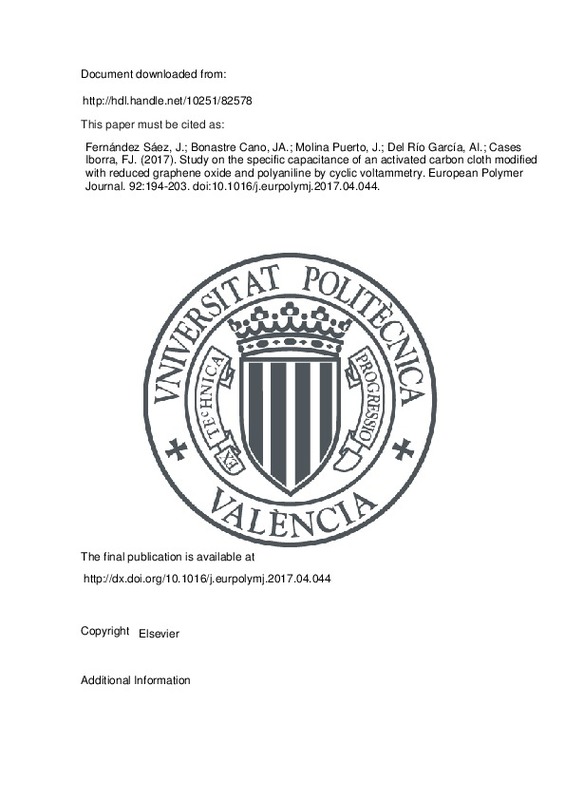JavaScript is disabled for your browser. Some features of this site may not work without it.
Buscar en RiuNet
Listar
Mi cuenta
Estadísticas
Ayuda RiuNet
Admin. UPV
Study on the specific capacitance of an activated carbon cloth modified with reduced graphene oxide and polyaniline by cyclic voltammetry
Mostrar el registro sencillo del ítem
Ficheros en el ítem
| dc.contributor.author | Fernández Sáez, Javier
|
es_ES |
| dc.contributor.author | Bonastre Cano, José Antonio
|
es_ES |
| dc.contributor.author | Molina Puerto, Javier
|
es_ES |
| dc.contributor.author | Del Río García, Ana Isabel
|
es_ES |
| dc.contributor.author | Cases Iborra, Francisco Javier
|
es_ES |
| dc.date.accessioned | 2017-06-08T12:31:05Z | |
| dc.date.available | 2017-06-08T12:31:05Z | |
| dc.date.issued | 2017-05-11 | |
| dc.identifier.issn | 0014-3057 | |
| dc.identifier.uri | http://hdl.handle.net/10251/82578 | |
| dc.description.abstract | This work describes a two-step process for the electrochemical coating of reduced graphene oxide (RGO) and polyaniline (PANI) onto an activated carbon cloth (ACC) by cyclic voltammetry (CV). The fact that the two syntheses are carried out independently of each other, makes it possible to select the experimental conditions for each one and to study the electrochemical response of RGO, PANI, and PANI onto RGO (RGOPANI), separately. Thus, by modifying the potential limits of the aniline-polymerization reaction, it was possible to observe the influence of RGO and the maximum amount of PANI that the carbon cloth can receive in terms of proper electrochemical response. Electrochemical properties were characterized by CV, galvanostatic charge-discharge curves (using three or two-electrodes symmetric cell configurations) and electrochemical impedance spectroscopy (EIS). A maximum improvement of 25%, 56% and 61% over the initial specific capacitance of ACC (about 129 F g−1) were obtained for RGO, PANI and RGOPANI coatings, respectively. Good cycling stability retaining 83% of the initial capacitance, after 1000 cycles stability test, was obtained for RGOPANI sample. Promising results of energy and power densities were also achieved. In the analyses by Fourier transform infrared spectroscopy (FTIR), the PANI-bands could be clearly identified which is indicative of a significant presence of PANI. Field emission scanning electron microscopy (FESEM) showed the morphology of RGO, PANI and RGOPANI onto the ACC fibers. These analyses helped to explain the electrochemical results. | es_ES |
| dc.description.sponsorship | The authors wish to acknowledge to Chemviron Carbon who kindly donated the ZORFLEX (R) activated carbon fabric. The authors wish to thank the Spanish Agenda Estatal de Investigacion (AEI) and European Union (FEDER funds) for the financial support (contract MAT2016-77742-C2-1-P). Tim Vickers is gratefully acknowledged for help with the English revision. | en_EN |
| dc.language | Inglés | es_ES |
| dc.publisher | Elsevier | es_ES |
| dc.relation.ispartof | European Polymer Journal | es_ES |
| dc.rights | Reserva de todos los derechos | es_ES |
| dc.subject | Activated carbon cloth | es_ES |
| dc.subject | Reduced graphene oxide | es_ES |
| dc.subject | Polyaniline | es_ES |
| dc.subject | Aniline adsorption | es_ES |
| dc.subject | Capacitance | es_ES |
| dc.subject.classification | QUIMICA FISICA | es_ES |
| dc.title | Study on the specific capacitance of an activated carbon cloth modified with reduced graphene oxide and polyaniline by cyclic voltammetry | es_ES |
| dc.type | Artículo | es_ES |
| dc.identifier.doi | 10.1016/j.eurpolymj.2017.04.044 | |
| dc.relation.projectID | info:eu-repo/grantAgreement/MINECO//MAT2016-77742-C2-1-P/ES/DESARROLLO DE MATERIALES POROSOS 2D Y 3D CON APLICACIONES ELECTROQUIMICAS, CATALITICAS, TERMICAS Y BIOMEDICAS/ | es_ES |
| dc.rights.accessRights | Abierto | es_ES |
| dc.contributor.affiliation | Universitat Politècnica de València. Departamento de Ingeniería Textil y Papelera - Departament d'Enginyeria Tèxtil i Paperera | es_ES |
| dc.contributor.affiliation | Universitat Politècnica de València. Escuela Politécnica Superior de Alcoy - Escola Politècnica Superior d'Alcoi | es_ES |
| dc.description.bibliographicCitation | Fernández Sáez, J.; Bonastre Cano, JA.; Molina Puerto, J.; Del Río García, AI.; Cases Iborra, FJ. (2017). Study on the specific capacitance of an activated carbon cloth modified with reduced graphene oxide and polyaniline by cyclic voltammetry. European Polymer Journal. 92:194-203. https://doi.org/10.1016/j.eurpolymj.2017.04.044 | es_ES |
| dc.description.accrualMethod | S | es_ES |
| dc.relation.publisherversion | http://dx.doi.org/10.1016/j.eurpolymj.2017.04.044 | es_ES |
| dc.description.upvformatpinicio | 194 | es_ES |
| dc.description.upvformatpfin | 203 | es_ES |
| dc.type.version | info:eu-repo/semantics/publishedVersion | es_ES |
| dc.description.volume | 92 | es_ES |
| dc.relation.senia | 337131 | es_ES |
| dc.contributor.funder | Ministerio de Economía y Competitividad | es_ES |







![[Cerrado]](/themes/UPV/images/candado.png)

